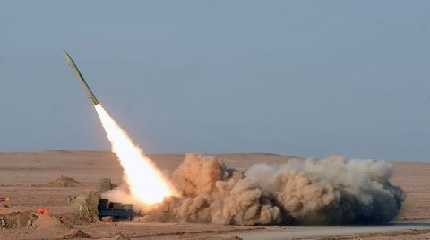
SEOUL, South Korea (AP) — North Korea on Tuesday fired what appeared to be a ballistic missile into its eastern sea, its second launch in a week, following leader Kim Jong Un’s calls to expand its nuclear weapons program in defiance of international opposition.
The launches follow a series of weapons tests in 2021 that underscored how North Korea is continuing to expand its military capabilities during a self-imposed pandemic lockdown and deadlocked nuclear talks with the United States.
South Korea’s Joint Chiefs of Staff said North Korea fired what likely was a ballistic missile from the area of its northern Jagang province. It said the weapon flew 700 kilometers (434 miles) at a maximum speed of around Mach 10 before landing in waters off its eastern coast, demonstrating a more advanced capability than North Korea’s launch last week.
The North’s state media described the earlier launch as a successful test of a hypersonic missile, a type of weaponry it claimed to have first tested in September.
South Korean officials didn’t provide a specific assessment of the missile type, but some experts said North Korea may have tested its purported hypersonic missile again in response to the South Korean military playing down its previous test.
Japan’s Defense Ministry said the suspected ballistic missile landed outside the country’s exclusive economic zone.
Prime Minister Fumio Kishida said officials were checking the safety of ships and aircraft around Japan, but there were no immediate reports of disruptions or damage.
“It is extremely regrettable that North Korea has continued to fire” missiles so soon after the U.N. Security Council discussed its response to the North’s earlier launch, Kishida said.
The Security Council held closed-door consultations on Monday on last week’s launch, but took no action. Ahead of the talks, the U.S. and five allies issued a statement urging North Korea to abandon its nuclear and ballistic missile programs.
South Korea’s presidential office said Tuesday’s launch was discussed at an emergency National Security Council meeting, whose members have urged North Korea to return to talks. President Moon Jae-in expressed concern that Pyongyang was dialing up its testing activity ahead of the South’s presidential elections in March.
The U.S. Indo-Pacific Command said the launch did not pose an “immediate threat to U.S. personnel or territory, or to our allies.”
Still, the launch corresponded with an order issued to ground some flights on the U.S. West Coast.
Sabrina LoPiccolo, a spokesperson for San Diego International Airport, told The Associated Press that it halted flights for up to seven minutes over a “national ground stop” at 2:30 p.m. local time, which was just minutes after the launch. She referred further questions to the Federal Aviation Administration, which did not respond to a request for comment.
Air-traffic controllers in other West Coast areas similarly ordered aircraft down, according to recordings shared online. A San Francisco air traffic controller ordered flights to avoid its airspace and not take off or land around the time without explaining why, according to a recording by the website LiveATC.net.
“Things are changing really quick,” the air traffic controller said in the recording, adding later: “I just heard something about ground-stopping all aircraft, so I don’t know anything, just hold tight there.”
An air-traffic controller at Seattle-Tacoma International Airport similarly told aircraft in the region they received an order for a “ground stop, all aircraft, all airports.” Air traffic controllers at Los Angeles International Airport also acknowledged receiving an order to stop departures at the same time, without explanation, according to another recording.
The launch came six days after North Korea fired a missile into the sea in what it described as a successful test of a hypersonic missile.
Seoul’s Defense Ministry said after that test that North Korea had exaggerated its capabilities and had tested a conventional ballistic missile the South was capable of intercepting. The ministry said it doubts that North Korea has acquired the technologies needed for a hypersonic weapon.
Analyst Cheong Seong-Chang at South Korea’s Sejong Institute said the North’s leadership would have been “enraged” by South Korea’s assessment of last week’s launch and may have planned a series of tests in a push to make its threat credible.
Hypersonic weapons, which fly at speeds in excess of Mach 5, or five times the speed of sound, could pose a crucial challenge to missile defense systems because of their speed and maneuverability. Such weapons were on a wish-list of sophisticated military assets Kim unveiled last year along with multi-warhead missiles, spy satellites, solid-fueled long-range missiles and submarine-launched nuclear missiles.
Experts say North Korea is likely years away from acquiring a credible hypersonic system.
North Korea’s previous test on Jan. 5 came days after Kim vowed during a key political conference to bolster his military forces, even as the nation grapples with pandemic-related difficulties that have further strained its economy, crippled by U.S.-led sanctions over its nuclear program.
The setbacks have left Kim with little to show for his diplomacy with former U.S. President Donald Trump, which derailed after their second meeting in 2019 when the Americans rejected North Korea’s demand for major sanctions relief in exchange for a partial surrender of its nuclear capabilities.
The Biden administration, whose policies have reflected a broader shift in U.S. focus from counterterrorism and so-called rogue states like North Korea and Iran to confronting a near-peer adversary in China, has said it’s willing to resume talks with North Korea “anywhere and at any time” without preconditions.
But North Korea has so far rejected the idea of open-ended talks, saying the U.S. must first withdraw its “hostile policy,” a term the North mainly uses to describe the sanctions and joint U.S.-South Korea military drills.
“Even with North Korea’s pandemic border lockdowns restricting trade and diplomacy, Pyongyang is determined to run an arms race against Seoul and deny Washington the luxury of focusing on Russia and China,” said Leif-Eric Easley, a professor at Ewha University in Seoul.




